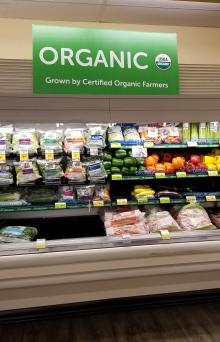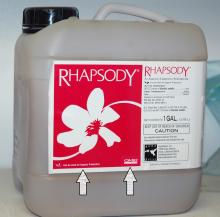Can I Use This Product on My Organic Farm?
1 Reviewed by Brian Baker (Organic Materials Review Institute), John Stalley (Oregon Tilth, Inc.) and Katherine Withey (WSDA Organic Program).
Responding to the increasing interest in organic agriculture the PNW Plant Disease Management Handbook has highlighted information about disease management materials and methods that are compliant with the USDA’s National Organic Program (NOP). Experienced organic growers, university plant disease specialists and the NOP emphasize the use of preventive and cultural methods for disease control. These include crop rotation, resistant cultivars, maintaining good air flow in the crop canopy, good soil and nutrient management, and sanitation measures. If these methods are insufficient to manage a disease, NOP-compliant inputs can be applied. All inputs must be included in the organic farm plan provided to the certification agency.
Most sections in this Handbook include information on cultural control. These methods are generally compliant with NOP standards. The Handbook also contains valuable information on the identification and life cycles of various diseases. Many mineral, biological and chemical disease management products are also listed, some of which are allowed for use on organic farms. This section provides guidance on how to evaluate these products for NOP compliance.
The O Symbol
The chemical and biological control sections in the Handbook use an O symbol to identify products that may be NOP compliant. This symbol indicates that the active ingredient in the material is allowed for use on organic farms. If a brand name product is identified, it was confirmed to be on the Washington State Department of Agriculture (WSDA) or Organic Materials Review Institute (OMRI) Brand Name Materials List at the time of writing (see “Brand Name Materials Lists”). However, when product formulations change, their compliance with NOP standards can also change. Before using a new product check up-to-date copies of published Brand Name Materials Lists and/or ask your certification agency whether the product is allowed for use on organic farms.
Allowed and Prohibited Substances
The NOP Standards were implemented on October 21st, 2002. The United States Department of Agriculture (USDA) has sole regulatory authority over the organic standard. There is now only one organic certification standard for agricultural products sold in the United States. The USDA accredits organic certification agencies to ensure that they certify operations for compliance with this standard. Certification agencies and other materials reviewers check whether a material is compliant with this Standard.
The organic rule §205.105 explains that synthetic materials are prohibited unless they are specifically allowed in the National List (§205.601), and that non-synthetic materials are allowed unless they are specifically prohibited in the National List (§205.602). So the National List only identifies materials that are an exception to the following rule: non-synthetic materials are allowed and synthetic materials are prohibited. The word synthetic is defined by the NOP (Appendix A). The National List does not identify allowed non-synthetic materials, the largest group of inputs used in organic agriculture. This group includes some of the most commonly used materials in organic production.
OMRI publishes a Generic Materials List which states whether commonly used generic materials are compliant with NOP Standards. In the list they indicate whether a generic material is allowed (A), restricted (R), or prohibited (P). Restricted materials have limitations on the way they are used on an organic farm. This list is widely used by certifying agents and other agricultural professionals interested in the NOP compliance of agricultural inputs. It is especially useful since it includes comments on many commonly used non-synthetic materials.
Allowed Synthetic Materials
When preventive practices and non-synthetic materials are insufficient to prevent or control diseases, allowed synthetic materials may be used. However, the conditions requiring such use must be documented in the farm plan.
The use of allowed synthetic materials is restricted. §205.601(i) lists synthetic materials allowed for disease control (Appendix A). If a material is listed for disease control it cannot be used for another purpose unless it is also listed for that purpose. For example, hydrated lime can be used for disease control, but not as a soil amendment. The use of some allowed synthetic materials is further restricted. For example, copper products must be used in a manner that minimizes accumulation in the soil, and the antibiotics streptomycin and tetracycline are allowed for fire blight control only. These restrictions are explained in the annotations in §205.601(i).
Many materials often thought of as natural are considered synthetic under the NOP because of the way they are manufactured. For example, sulfur is listed as an allowed synthetic input because much of the sulfur used in agriculture comes from the scrubbers on the smokestacks of petroleum and natural gas refineries. Therefore, sulfur falls under the definition of synthetic due to the chemical reaction occurring in the scrubbers.
Most inert ingredients used in synthetic pesticides are prohibited under the NOP (§205.601(m)). The Environmental Protection Agency (EPA) categorizes inert ingredients according to the level of toxicological concern. EPA List 4 is the list of materials that have been shown to be of minimal concern. To be NOP compliant, all synthetic inert ingredients in pesticides must be on EPA List 4 (7) unless they appear specifically on the National List or are used in passive pheromone dispensers. Inert ingredients do not appear on labels, so verifying compliance with this annotation can be challenging.
Brand Name Materials Lists
The NOP accredits organic certification agencies but does not review individual materials for compliance with NOP standards. Organic growers are responsible for ensuring that the materials they use are compliant with organic standards. Organic certification agencies provide third party verification that the standards, including the use of inputs, are being met.
Two brand name materials lists published in the Pacific Northwest are widely used by growers and certification agencies to verify the NOP compliance of agricultural inputs. One is published by OMRI, the other is published by the WSDA Organic Program, both are available online (4, 5). When manufacturers subscribe to these lists all ingredients and the manufacturing processes are reviewed for compliance to NOP standards. Only compliant materials are included on the lists. Remember that some allowed synthetic materials, such as copper and micronutrients, have restrictions on their use rather than their manufacture. Whenever considering use of a new input it is prudent to ask your certification agency whether the material and the use is NOP compliant.
Some NOP-compliant products are not listed on the OMRI or WSDA lists since not all manufacturers subscribe to OMRI or WSDA. Your certification agency and the OMRI Generic Materials List can help you evaluate whether the active ingredients listed on the label are NOP compliant. Remember that any synthetic inert ingredient in a pesticide must be on EPA List 4.
Record Keeping Requirements
The organic system plan or farm plan is part of the application form and includes any updates provided to the certification agency. Sample forms are available from certification agencies. This plan is the basis of the record keeping system that is reviewed during the certification process. If allowed synthetic inputs are used it is especially important to describe preventive disease management strategies in the farm plan in order to help demonstrate that these pesticides are only used when preventive methods are insufficient to manage disease.
All inputs must be included in the farm plan; this is required under the NOP but also allows inputs to be reviewed by the certification agency before use. When the inspector visits, product labels are sometimes sufficient to demonstrate NOP compliance of a brand name product. For example, if using sulfur or a microbial product, the label indicates that the active ingredient is allowed for disease control. If the product is OMRI or WSDA listed, the label will verify the brand name product used and that any synthetic inert ingredients are also allowed. If a product is not OMRI or WSDA listed, the label will help to verify whether active ingredients are allowed, but confirmation from the manufacturer that all synthetic inert ingredients are also allowed (on EPA List 4) will be required. Records of this confirmation must be maintained.
Pesticide application records are also reviewed during inspections. These can be kept in whatever form is adapted to the farm, but they must be sufficient to demonstrate compliance with the NOP. Normally a record of the material used and the date, rate and location of application is sufficient. In the case of copper materials, pesticide application records can help verify whether copper is “used in a manner that minimizes accumulation of copper in the soil”, as required by §205.601(i).
One Step at a Time
Before using a new product check for recent OMRI or WSDA approval of the product. If it isn’t listed, follow these steps:
- Evaluate each label ingredient for compliance with the NOP and any annotations in the National List. The OMRI Generic Materials List may also be helpful.
- Contact the manufacturer if necessary.
- Document the satisfaction of any annotations.
Be sure to contact your certification agency if you have any doubt about the NOP compliance of a material.
References and Additional Resources
- National Organic Program and NOP Standards: http://www.ams.usda.gov/nop/
- List of Accredited Certifying Agents: http://www.ams.usda.gov/nop/CertifyingAgents/ Accredited.html
- Oregon Tilth, Inc.: http://www.tilth.org/
- WSDA Organic Program: https://agr.wa.gov/organic
- Organic Materials Review Institute: http://www.omri.org/
- Organic Farming Compliance Handbook: http://www.sarep.ucdavis.edu/organic/complianceguide/ intro.htm
- EPA Lists of Inert Ingredients: http://www.epa.gov/opprd001/inerts/
Appendix A
National Organic Program on Materials
Synthetic. A substance that is formulated or manufactured by a chemical process or by a process that chemically changes a substance extracted from naturally occurring plant, animal, or mineral sources, except that such term shall not apply to substances created by naturally occurring biological processes.
§205.601 Synthetic substances allowed for use in organic crop production.
In accordance with restrictions specified in this section, the following synthetic substances may be used in organic crop production:
(i) As plant disease control
(1)Coppers, fixed — copper hydroxide, copper oxide, copper oxychloride, includes products exempted from EPA tolerance, Provided, That, copper-based materials must be used in a manner that minimizes accumulation in the soil and shall not be used as herbicides.
(2)Copper sulfate—Substance must be used in a manner that minimizes accumulation of copper in the soil.
(3)Hydrated lime
(4)Hydrogen peroxide
(5)Lime sulfur
(6)Oils, horticultural, narrow range oils as dormant, suffocating, and summer oils.
(7)Peracetic acid—for use to control fire blight bacteria.
(8)Potassium bicarbonate
(9)Elemental sulfur
(10)Streptomycin, for fire blight control in apples and pears only
(11)Tetracycline (oxytetracycline calcium complex), for fire blight control only
(m) As synthetic inert ingredients as classified by the Environmental Protection Agency (EPA), for use with nonsynthetic substances or synthetic substances listed in this section and used as an active pesticide ingredient in accordance with any limitations on the use of such substances.
(1) EPA List 4—Inerts of Minimal Concern
(2) EPA List 3—Inerts of Unkown Toxicity – for use only in passive pheromone dispensers.
§205.602 Nonsynthetic substances prohibited for use in organic crop production.
The following nonsynthetic substances may not be used in organic crop production:
(a) Ash from manure burning
(b) Arsenic
(c) Calcium chloride, brine process is natural and prohibited for use except as a foliar spray to treat a physiological disorder associated with calcium uptake.
(d) Lead salts
(e) Potassium chloride—unless derived from a mined source and applied in a manner that minimizes chloride accumulation in the soil.
(f) Sodium fluoaluminate (mined)
(g) Sodium nitrate—unless use is restricted to no more than 20% of the crop’s total nitrogen requirement.
(h) Strychnine
(i) Tobacco dust (nicotine sulfate)
(j-z) [Reserved]



